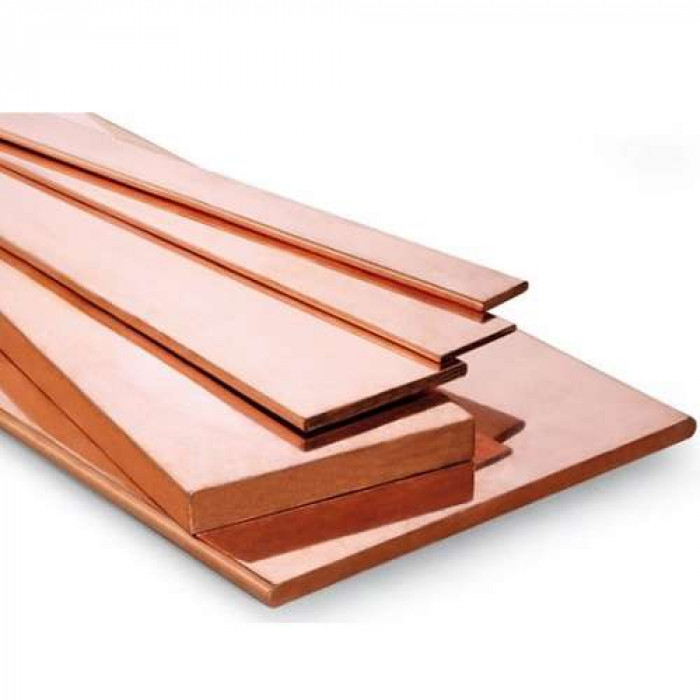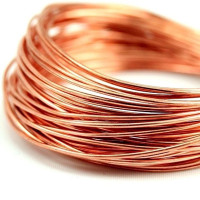Odessa copper electrical busbar (strip) M1 8x50mm and other sizes, aluminum electrical busbar (strip) AD0, AD31 choice
The main area of application of the copper electrical bus is the distribution and supply of electricity in electrical panels not only of industrial buildings, but also of residential buildings. Also, copper tires are in demand in microelectronics, radio engineering, medical, military, aviation and space fields.
An electrical copper bus is the basic element of any switchgear or conductive device. Of these, trunk and trolley busbars are mounted.
Characteristics of the copper bus
Copper electrical busbars have reliability, durability, high throughput, dynamic stability.
The operating temperatures of the electrical copper bus are from -55 °С to +280 °С.
The minimum value of temporary resistance to rupture is 637 MPa according to GOST 434-78).
Specific resistance is not more than 0.01724*10-6 Ohm*m.
Maximum operating voltage up to 1000 V.
Thermal conductivity 401 W/m × K.
However, the characteristics and properties of the copper bus will depend on the production technology and the composition of the raw materials that may have impurities. Today there are more than 10 grades of copper.
The raw material for the manufacture of a copper busbar can be rolled bars, copper rod, ingots or pressed copper billets, however, they contain impurities to one degree or another that change the properties of the final product.
So, the admixture of oxygen, in an amount of up to 0.001%, creates difficulties in soldering and welding, impurities of lead and zinc make the copper bus more brittle during heating, and impurities of silver (0.05% by weight) reduce "creep" and softening when heated. without a drop in electrical conductivity, but significantly increase the cost of the product.
The content of phosphorus (P), iron (Fe), arsenic (As), antimony (Sb) reduce the electrical conductivity.
Production technology and type of copper
Regulated by GOST 859-2014
Cathode copper: M00k, M1k
Production technology: electrolytic refining at the final stage of copper ore processing. Product: copper cathodes.
Electrolytic commercially pure copper: M00, M0, M1.
Production technology: remelting of cathodes in a normal atmosphere. Increased oxygen content. No phosphorus.
Oxygen-free electrical M00b
Production technology: remelting cathodes in a vacuum, reducing or inert atmosphere reduces the oxygen content.
Oxygen-free M0b
Production technology: remelting cathodes in a vacuum, reducing or inert atmosphere reduces the oxygen content.
Phosphorous, with low residual phosphorus M1p
Production technology: remelting of scrap and copper cathodes with phosphorus deoxidation. Increased oxygen content
Phosphorous, with high residual phosphorus M1f
Production technology: remelting of scrap and copper cathodes with phosphorus deoxidation. Increased oxygen content
So, the most common grades of copper in the manufacture of electrical tires:
M0b. Oxygen-free electrorefined copper (99.97%) with an oxygen and bismuth content of 0.001%; phosphorus, arsenic, antimony, tin and nickel - no more than 0.002%; sulfur, lead and zinc - up to 0.003%; iron - up to 0.004%.
M1. Commercially pure copper (99.90%), remelted from cathodes in a normal atmosphere, with an oxygen content of up to 0.05%; bismuth - 0.001%; arsenic, antimony, tin and nickel - no more than 0.002%; sulfur and zinc - up to 0.004%; lead and iron - up to 0.005%. Phosphorus and silver are not standardized according to GOST. If this brand is intended for the electrical industry and is subject to electrical conductivity tests, the letter E (M1E) is additionally added to its designation.
M2. Remelted from scrap copper (99.70%), contains 0.07% oxygen; up to 0.002% - bismuth; up to 0.005% - antimony; not more than 0.01% - sulfur, lead and arsenic; up to 0.05% - tin and iron. Zinc, phosphorus and silver are not standardized according to GOST. Like M1, it requires special conditions for welding or soldering.
Different grades of copper have different resistance:
M2 (waste and scrap) - 0.020 μOhm × m;
M1 (semi-solid, solid, pressed rods) - 0.01790 μOhm × m;
M1 (annealed bars and tapes) - 0.01748 μOhm × m;
M1 (horizontal cast ingots and class C wire rod) - 0.01724 μOhm × m;
M0 (class B wire rod) - 0.01718 μOhm × m;
M00 (class A wire rod and vertically cast ingot) - 0.01707 μOhm × m.
The quality of copper used for the production of electrical tires must be at least M1 in accordance with GOST 859-2014.
According to technical conditions, for example, TU 48-0814-105-2000, it is allowed to produce tires from M2, however, such products will have worse characteristics: higher electrical resistance, low thermal conductivity, poor corrosion resistance and strength.
The manufacturer is obliged to indicate the grade of copper in the Quality Certificate.
Another important point that you need to pay attention to is the type and form of rental.
Types of rolled copper bar
Soft honeytires (SMM) are produced on long lines of metal-roll by hot pressing by continuous extrusion and are wound up with a length of 10 m. SMM are used in all areas of industry, from aircraft construction to metallurgy.
Solid copper busbars (SCM) are produced on long-length metal-rolling lines by cold drawing from oxygen-free hot-pressed copper by continuous extrusion and cut into strips from 1 to 6 m long. They have a lower conductivity than SMM and are used to create strong and immovable busbars.
Soft (SMM) and hard (ShMT) tires are used as cable replacement.
Braided copper bars are made from thin copper wires. They are more flexible than solid (CMM/CMT) tires and are in demand in high vibration conditions - for example, in transformer bridges.
Insulated copper busbars are used in aggressive environments, and under high loads - two- or three-lane.
Solid and perforated tires. Perforated busbars are used in remote electrical cabinets, they are easy to assemble and install.
Radius copper bars are rectangular bars with rounded corners. The rounding radius is specified in GOST 434-78.
The most universal are copper electrical busbars ShMT and ShMM in strips, rectangular section, without insulation.
Some manufacturers of electrical busbars try to reduce the cost of their products by purchasing copper of dubious quality or using copper scrap, since the price of copper occupies the main share in the price of the final product. That is why it is worth being critical of goods with a value significantly “below the market”.
All responsible manufacturing plants that monitor the high quality of their products purchase copper at the prices of the London Metal Exchange (LME). Accordingly, a high-quality tire from different manufacturers more or less has the same cost. At the same time, with a change in the price of copper on the exchange, the price of products from it also changes.
When purchasing a copper bus, it is important:
Pay attention to the price and the manufacturer.
If the plant is "full cycle" and has its own copper smelting production, including rolled metal, then this serves as an additional guarantee of product quality.
If the plant has a QCD, its own laboratory, then this will also be a weighty argument in choosing a supplier-manufacturer.
For example, one of the largest manufacturers of electrical copper bus Cable Plant "EXPERT-KABEL" uses for the manufacture of soft bus (SMM) copper rod grade M1, M0, M00 by hot pressing, preparing raw materials in its own melting furnaces and strictly adhering to GOST 434-78.
Solid tire (SHMT) is made by cold drawing from oxygen-free hot-pressed copper, which makes it possible to obtain products of the highest quality, exceeding the GOST parameters. Our own laboratory checks both incoming raw materials and the quality of finished products. For each batch, a Quality Passport and relevant certificates are issued.
Modern equipment of the plant makes it possible to produce more than 30 standard sizes of copper bars with a cross section from 60 to 3800 mm2, including those according to the individual size of the customer. The cutting length of the tire can vary from 1 to 12 meters, which allows you to take into account different needs.
Tires are packed in wooden boxes, however, lighter packaging is possible upon agreement with the customer.
The aluminum electrical bus is a strip of random length and is sold in coils or bundles, this is a profile that has a cross section from three to twelve mm thick and a width from ten to one hundred and eighty mm.
If we consider aluminum tires in terms of strength, then they are divided into two main types:
- with normal strength without additional signs;
- with increased strength with PP marking.
The name of aluminum tires includes data on heat treatment, type of strength, GOST in accordance with which it was produced, as well as on the metal or alloy grade from which they are made.
These aluminum products are quite in demand due to their characteristics:
- products are durable, can serve up to twenty-five years, due to corrosion resistance;
- light weight and at the same time an excellent indicator of density, as well as the required level of thermal conductivity;
- due to the indicators of plasticity and non-magnetism, aluminum electrical busbars are used not only in distribution equipment, but also in all types of current conductors;
– these products are often used for decorative work on vehicles and various modern equipment, as they have a beautiful appearance.
Main production features
Aluminum tires are manufactured according to two main standards: GOST 15176-89 and GOST 8617-91, the composition of the material must comply with GOST 24231-80. For the manufacture of these products, the following grades of aluminum are used: A7, A5, A5E, AD0, AD00, as well as two main alloys: AD31E or AD31. To date, pure aluminum is most often used for the production of aluminum tires, whichti without impurities (AD0) or high-quality alloy AD31, the chemical composition of which contains silicon and magnesium, while it has an excellent level of resistance and electrical conductivity is less than that of ordinary technical aluminum.
Main Applications for Aluminum Strips
These universal products have a huge range of applications: for mounting busbars, in the field of mechanical engineering, civil and industrial construction, for the production of housings for various equipment, profiles, as well as in the energy sector. Tires that are made of the AD0 brand are indispensable in working with hinged facades and all types of outdoor advertising. Aluminum tires are a guarantee of high-quality sealed seams on industrial pipes, which reliably protect them from dirt and dust.
Advantages of aluminum electrical busbars
All the main advantages of aluminum electrical tires are associated with the properties of the metal used for their manufacture. After all, aluminum is characterized by:
high electrical conductivity;
small specific weight;
sufficiently low cost;
high corrosion resistance;
lack of toxicity;
considerable strength.
Due to their high electrical conductivity, at a lower cost and light weight compared to copper busbars, aluminum busbars are widely used in the installation of current conductors, switchgears or busbar assemblies. Aluminum tires provide a service life of 25 years.
The scope of aluminum tires is quite wide. Aluminum tires are needed to make decorative parts in construction and engineering. Specific examples of the use of aluminum tires include the following: finishing of aircraft, cars, building facades, interiors. Aluminum tires are widely used in the electric power industry. All this is due to its high electrical and thermal conductivity, ductility, non-magnetism. Aluminum strips can be found in switchgears, rigid conductors, busbars. This material is non-toxic and can be used for a long time in difficult conditions.
No questions about this product, be the first and ask your question.





